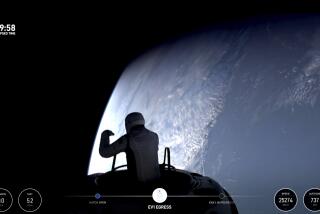Adrift in the Heavens, Glenn Reasserts Faith in God
- Share via
HOUSTON — After three full days back in orbit, John Glenn turned reflective Sunday, saying that gazing out the shuttle Discovery’s windows at vast and recognizable chunks of Earth from 350 miles in space has served to strengthen his faith.
Asked whether he prayed in space, Glenn replied: “I pray every day, and I think everybody should. I don’t think we can look at Earth every day--to look out at this kind of creation and not believe in God is, to me, impossible.”
Although the 77-year-old senator from Ohio is kept busy on several geriatric experiments, he also has more time to contemplate the universe than he did when he was the first American to orbit Earth in 1962. On that mission, he circled the planet three times before splashing down in the Atlantic less than five hours after he blasted off.
Glenn and the crew will circle the globe 144 times in nine days before a scheduled landing Saturday at Florida’s Kennedy Space Center.
Glenn, the oldest person to fly into space, said he began to muse about the role of faith in his life after passing over the Middle East. He said he saw “the Red Sea, and Cairo, and I looked down and wondered why we can’t solve some of the problems in that part of the world.”
Glenn said he watched in wonder as thunderstorms raked Africa, noting “600 or 700 lightning flashes.” Later, he said, he and the other six astronauts on board the shuttle passed over Cape Canaveral, Fla., and could see at one time “4,000 miles of Earth go by.
“We could see the whole eastern third of the U.S., all the way to the Great Lakes and Canada, and to see that laid out like that, from this vantage point, it only strengthens my faith.”
Glenn’s reflections came during a press conference at the Johnson Space Center, where reporters assembled for a 35-minute link to Discovery as it passed over the U.S.
The shuttle crew had already completed several assignments, including the release of a Spartan satellite that is to collect images of the sun’s outer atmosphere. The crew is to catch up to the 3,000-pound satellite again Tuesday, pull it back aboard and collect its data.
A similar maneuver went awry last November when astronauts on board the shuttle Columbia using a robotic arm to retrieve an identical satellite sent it into an awkward tumble. Two crew members then embarked on a risky spacewalk to fetch the $11-million satellite.
Both Glenn and Discovery commander Curtis L. Brown were seated in the shuttle’s mid deck in front of a large American flag to field questions, but predictably, most were aimed at Glenn.
The first came from veteran television journalist Walter Cronkite, who is 81 and a personal friend of Glenn. Cronkite asked if weightlessness was of any benefit to an elderly person. Glenn laughed, and then responded: “Well, as you get older you tend to drop things. But here when you do, it floats, and you can catch up with it.”
Although he expected to feel some nausea after returning to space after 36 years, he has not, he said.
Glenn was to go to sleep Sunday wired to a series of monitors that will record his rate of breathing, snoring and eye movements.
In Washington on Sunday, NASA administrator Daniel S. Goldin again defended the scientific validity of sending Glenn aloft but also conceded: “America owed him one. This is a reward for being a great American and a hero.”
After Glenn’s 1962 mission, President Kennedy declared him too valuable to risk sending into space again and prohibited NASA from considering him for another flight.
More to Read
Sign up for Essential California
The most important California stories and recommendations in your inbox every morning.
You may occasionally receive promotional content from the Los Angeles Times.













